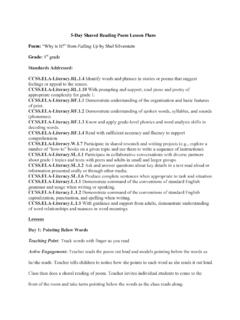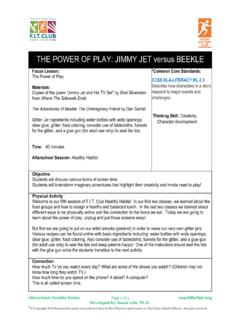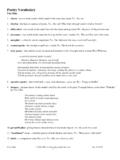Transcription of Teaching an Attitude of Gratitude to Young Children
1 1 Teaching an Attitude of Gratitude to Young Children Modeling thankfulness can help instill the character trait of Gratitude and caring in your child s life. Posted on January 10, 2013 by Gail Innis, Michigan State University Extension Just say, Thank you. How many times do Children hear and parents and caregivers say that phrase? With the holiday season fresh in our memories, it might be time to make a resolution to teach your Young Children an Attitude of Gratitude rather than to just respond to your prompts and reminders to say thank you . Gratitude is one piece of the character trait of being caring and is more than the cursory thank you. Real thankfulness requires thought, energy and more than just doing the right thing. Thankfulness impacts the giver as well as the receiver. Forcing a child to say thank you doesn t teach the child to think about what they are thankful for and why.
2 Teaching and learning real Gratitude takes time and repeated modeling by adults. Thankfulness begins when we are able to recognize and point out small things that make us thankful. Adults can model the behavior through daily words and actions: I m so thankful for the sunshine that warms me inside and out. Isn t it nice when grandma watches the baby so you and I have extra time to cuddle together? Dad works so hard. Why don t we make a special meal to show him how much we appreciate him? You teach Children how to be grateful when you express your own Gratitude openly and model thankfulness through your actions. There are many simple ways that you can begin to teach your Children the Attitude of Gratitude . Try some of these ideas with your Children or explore additional ideas from the Random Acts of Kindness Foundation: Discuss a gift that your child received from a family member during the holidays.
3 Talk about what the child liked about the gift. Talk about the gift giver and how nice it is to be remembered and appreciated by someone. Have your child draw a picture or write a note of thanks to those who gave them a gift. Talk about how it feels to get a note or letter in the mail. Assist your child, depending on their age and developmental stage, in addressing and mailing the note. Putting feelings on paper can make them more real for a child. 2 Make a thank-you phone call to a long distance grandparent, aunt, uncle, or family friend who sent holiday greetings to your family or child. Encourage your child to talk about what he received and how he will be using his gift. Involve your Children in local charitable events. Stay informed about community endeavors that help those who are less fortunate through local newspapers and radio.
4 Discuss upcoming events in routine family conversation and brainstorm ways that your family could assist. Include your Children in a discussion on which charity you d like to support and why. Even a very Young child can assist in choosing a toy for a holiday toy drive for Children who less fortunate. Tell and read stories about generous people and characters. The book The Giving Tree by shel silverstein might be a way to open a conversation about the Attitude of Gratitude . In the Children s book Have You Filled a Bucket Today? author Carol McCloud gives us an easy way to teach our Children the power of affirming words and actions. Take advantage of the long winter days and assist your child with weeding out old toys, books and clothing that they no longer use or want. Talk about how other Children might appreciate something that they have outgrown.
5 Explore local thrift stores, pantries or organizations that distribute used items and deliver your donation. Be certain to check ahead for rules on what the group will take for distribution. Have a Saturday family baking day and prepare small packages of homemade items to share with an elderly neighbor or a service provider (the mail carrier, bus driver or teacher). Pay attention to people you observe who display generosity and kindness and point out the actions to your child. For example, Wasn t it nice of daddy to help grandma with her heavy winter coat? Or, Did you see that man pick up the litter that someone threw down in the park? Say thank-you out loud when someone opens a door for you, lets you cut in front of them in the check-out line at the store or brings you your morning cup of coffee. Take time each day at the family table or at bedtime to mention one thing that you are thankful for.
6 It is never too early to begin Teaching Gratitude . In Winnie the Pooh, Piglet noticed that even though he had a Very Small Heart, it could hold a rather large amount of Gratitude . Don t miss an opportunity to model and teach kindness, Gratitude and compassion. These are character traits that can enhance your child s overall growth and development and can buffer your child against a culture that often concentrates on me first. For more articles on child development, academic success and parenting, please visit the Michigan State University Extension website. This article was published by Michigan State University Extension. For more information, visit To have a digest of information delivered straight to your email inbox, visit To contact an expert in your area, visit , or call 888-MSUE4MI (888-678-3464).
7 3 Related Events This is Your Brain Online: The Impact of Digital Technology on Mental Health Dec 10, 2015 | Webinar Mindfulness and Adolescence: Windows of Opportunity to Enhance Health and Well-Being Dec 16, 2015 | Webinar Related Articles Helping Children and teens learn to deal with stress June 2, 2014 | Erin Ross | Children and teens deal with just as much stress as adults. Adults can help by Teaching youth skills to deal with stress in healthy, positive ways. Bouncing and stretching: building resilience in Children and youth January 27, 2014 | Kendra Moyses | Learn how you can help your child learn to stretch their limits and bounce back when set-backs happen with these seven easy ways to build resilience in kids.










